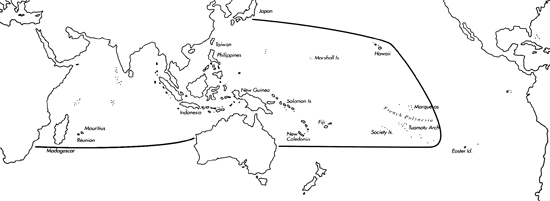Range: Entire Indo-Pacific.
Description: Small to medium-sized, light to moderately solid. Last whorl conical to broadly conical or slightly pyriform; outline nearly straight to slightly sigmoid. Shoulder angulate to carinate, smooth to tuberculate, with a deep exhalent notch. Spire usually high, outline variably concave. Larval shell of 3.5-4 whorls, maximum diameter of 0.8-0.9 mm. First 8-10 postnuclear whorls tuberculate, following whorls undulate to smooth. Teleoconch sutural ramps flat to slightly concave, with 0 increasing to 3-6 spiral grooves crossed by arcuate radial threads. Last whorl with strong spiral ribbons or ribs, separated by narrow to occasionally broad spiral grooves with strong axial threads.
| Shell Morphometry | ||
|---|---|---|
| L | 22-38 mm | |
| RW | 0.04-0.13 g/mm | |
| RD | 0.65-0.75 | |
| PMD | 0.80-0.93 | |
| RSH | 0.23-0.37 | |
Ground colour white. Last whorl variably patterned with light to dark brown: Largely brown except for small scattered ground-colour blotches at shoulder and centre, or white flecked with brown, or white spirally spotted with brown, or all white. Larval whorls white. Spire variably streaked with brown. Aperture white.
Periostracum brown, thin, translucent, smooth.
Dorsum of foot white to pale yellow, with adotted brown wing-shaped pattern on anterior part continuing as a dotted brown pre-marginal line posteriorly; anterior edge with a black spot on each side of a triangular brown central fleck. Sole of foot white. Tentacles white, suffused with tan and tipped with black. Siphon white, suffused with beige to light brown dorsally; tip immaculate (Red Sea: Fainzilber et al., 1992; Papua New Guinea: Chaberman, pers. comm., 1981). Sole of foot buff anteriorly and light brown posteriorly. Rostrum buff. Siphon buff at tip, darker tan proximally (Hawaii: Kohn & Weaver, 1962) (Pl. 76, Fig. 61).
Habitat and Habits: Usually in 3-100 m, adults sometimes in 0.5-5 m, juveniles sometimes as deep as 180 m. On coral or shell sand often mixed with coral rubble, on muddy sand and on fine shell rubble with seaweed (Fainzilber, 1985; Fainzilber & Mienis, 1986; Fainzilber et al., 1992; Grosch, pers. comm., 1989; Tirard, pers. comm., 1989).
Discussion: C. acutangulus resembles C. milesi, C. praecellens, C. tuberculosus, and C. helgae. C. milesi is smaller (to 27 mm) and has a narrower last whorl (RD 0.49-0.59) and a paucispiral larval shell (1.75-2 whorls). C. praecellens is larger (to 63 mm) and differs in the absence of tubercles on its late postnuclear whorls, the greater number of spiral grooves on its late sutural ramps, and in the lower number of whorls of its larval shell (about 2.5 whorls). For comparison with C. tuberculosus and C. helgae, see the Discussions of those species. C. turriculatus (Pl. 54, Fig. 22) and C. gemmulatus refer to white shells of C. acutangulus.

C. acutangulus range map
This section contains verbatim reproductions of the accounts of 316 species of Conus from the Indo-Pacific region, from Manual of the Living Conidae, by Röckel, Korn and Kohn (1995). They are reproduced with the kind permission of the present publisher, Conchbooks.
All plates and figures referred to in the text are also in Röckel, Korn & Kohn, 1995. Manual of the Living Conidae Vol. 1: Indo-Pacific Region.
The range maps have been modified so that each species account has it own map, rather than one map that showed the ranges of several species in the original work. This was necessary because each species account is on a separate page on the website and not confined to the order of accounts in the book.